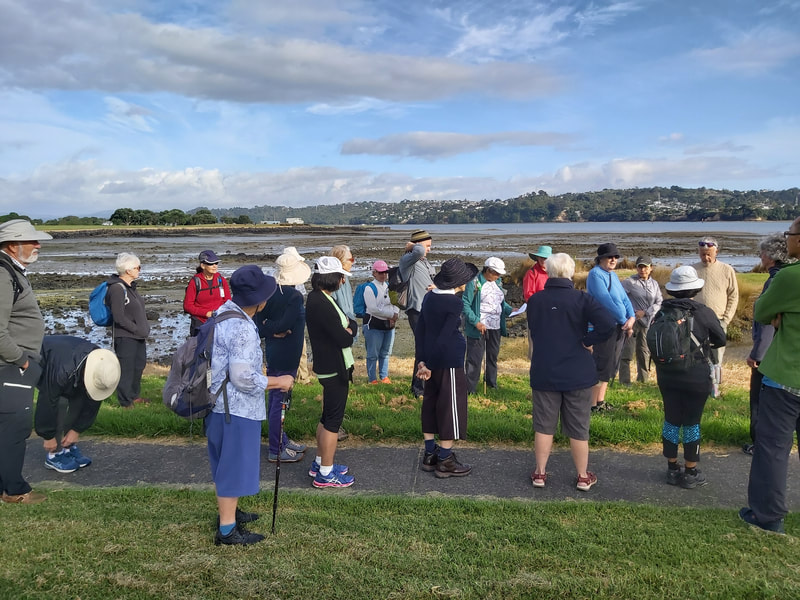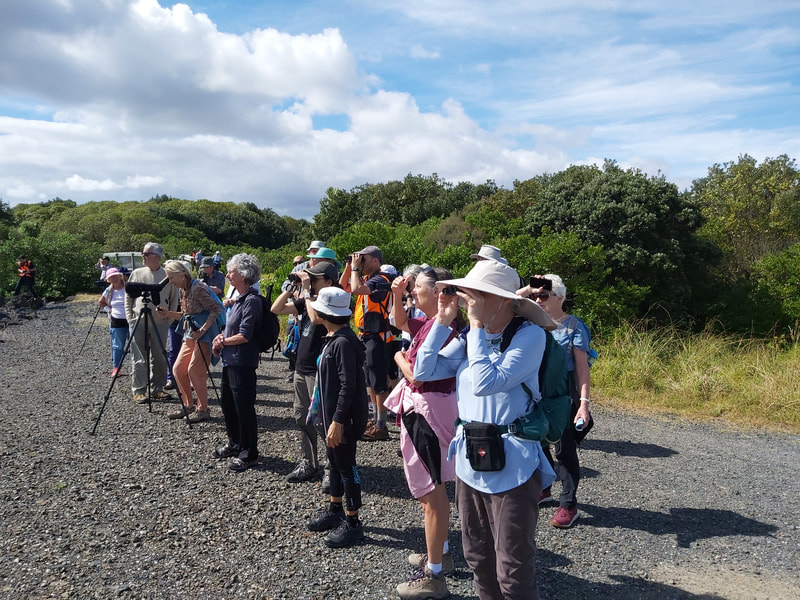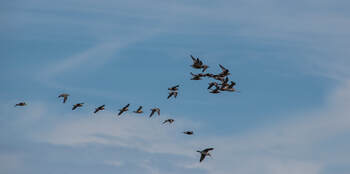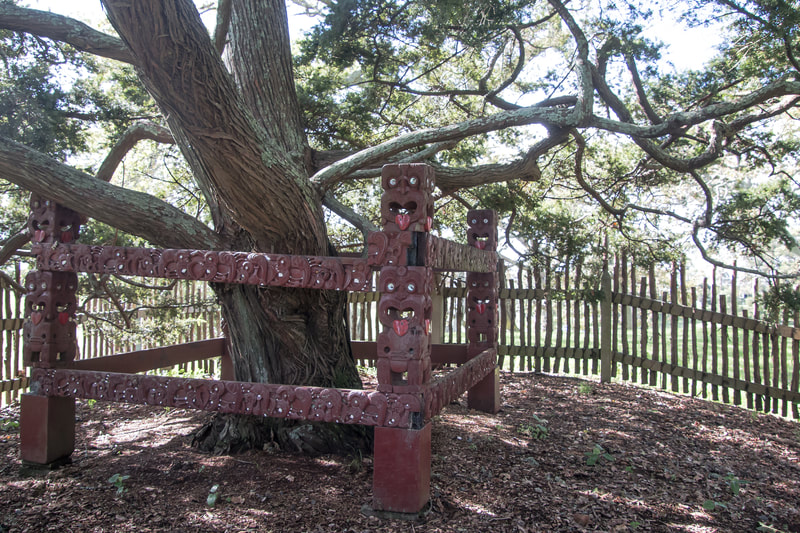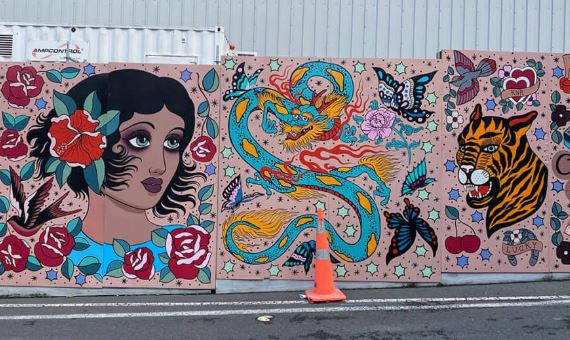Trip Reports: February - March 2023
26 March 2023 - Mangere: Esplanade, Mountain and Bird- Watching
We managed to fit three walks in on this local trip, each different from the others.
The first was along Kiwi Esplanade and was all about mangroves: which plants like to grow close to them, grow in a mangrove (very few!) and the benefits of having mangroves. Of the two trees we saw at the start of our walk, karo and ngaio, the ngaio was the Tasmanian species, with a few flowers still on it. Both grown close to salt water, but not in it.
The first was along Kiwi Esplanade and was all about mangroves: which plants like to grow close to them, grow in a mangrove (very few!) and the benefits of having mangroves. Of the two trees we saw at the start of our walk, karo and ngaio, the ngaio was the Tasmanian species, with a few flowers still on it. Both grown close to salt water, but not in it.
We then went on to look at plants growing in the mangrove habitat itself. Salicornia pacifica takes root in salt water, absorbs the water and can expel some salt, though it stores a lot of it; but importantly, it expels some oxygen down into the soil/mud through its roots. This benefits Avicennia and any other plant taking root in the saline habitat: So, Salicornia is a pioneer species and helps to establish a wetland system able to remove some carbon from the atmosphere. Avicennia is one of the most highly salt tolerant of all species found in mangrove habitats.
Next we went on to Mangere Mountain, one of the best- preserved craters in the Auckland volcanic field. There are two cones here, one higher than the other, with a very wide rim. Jenny described how magma would have forced its way through the earth’s crust with great force at this point, then the magma meeting ground water would have caused violent explosions, resulting in the formation of the tuff ring. The “plug” would have been formed when semi- liquid lava flowed out from a breech in the crater to form a “tholoid,” this one being the only such “plug” in the entire Auckland volcanic field.
We split into two groups at the mountain, where most of us went all the way around the rim and a small number went along the gradual slope some way up on the west side. Both groups got good views of most of Auckland and could identify several local features.
Next, we set off for Ambury Regional Park where we had plenty of time for lunch and a comfort stop before meeting Ian McLean and his colleagues from Birds New Zealand. Five volunteers met us at the park entrance and after a short safety briefing, took us through a paddock where we saw a pair of paradise shell- ducks before we walked through onto the track.
Following the shoreline, we were fortunate to be able to view many birds through the telescopes the volunteers brought along. We saw some godwits, wrybill, kingfisher, Caspian terns, a white- faced heron and of course large flocks of black- backed gulls and some pied oystercatchers.
The biggest surprise, however, was to see spoonbills – vast numbers of them – whereas we had only ever seen a few at a time, in other locations!
The volunteers shared so much information, answered our questions and found various birds in the sights of their telescopic lenses; it was a wonderful experience! So thank you, Birds New Zealand!
Thank you to leaders Praemi and Jenny for three very different walks.
Text: Praemi; Photos: Sue, Barbara and Linda.
Text: Praemi; Photos: Sue, Barbara and Linda.
12 March 2023 - Long Bay

On a beautiful sunny Sunday our group of 35 walkers set off on the bus for Long Bay.
We started our walk high above Long Bay in Fitzwilliam Drive, with the intention to walk DOWN to the Bay, where we planned to meet up with our bus again.
The first point of interest was Stredwick Drive Drainage Ponds with it’s large population of ducks. Interesting to see an area in suburbia that has a series of ponds constructed to deal with rainwater, something we are all very aware of after the recent weather events in Auckland. This area was obviously put under great pressure recently, as evidenced by a broken concrete culvert wall and lots of washed-up debris.

A bit of street walking brought us to the lovely, shady Awaruku Bush Reserve, where we saw an area that had been rock quarried in the past and is now being regenerated by the bush.
In this area there were a lot of kahikatea (white pine) which is the tallest tree in the NZ forest. We saw one that has been estimated to be 650 years old, reaching far above the surrounding canopy.
The small orange berries of the kahikatea were a valued food source for Maori, but were a challenge to harvest from these giant trees. The easy pickings were the fallen berries on the ground.
We had our morning tea stop on a long and daunting series of wooden steps that lead out of the bush. By stopping half way up for a break, we had a chance to recover our breath by the time we set off to finish the steps.
After enjoying some lovely views of the Hauraki Gulf and it’s islands from Moorgreen Heights, we walked along Glenvar Road to the new access road leading to Long Bay Village, Glenvar Ridge Road. As we followed this road down we passed a pou carving, new houses being constructed, and enjoyed a great view of Tiri Island.
We walked through another bushy stormwater drainage area with ponds and ducks, which brought us out at Long Bay Village, with it’s two large stainless steel arches welcoming visitors to the Village. Designed by Gregor Kregar and installed in 2019, they consist of thousands of triangles of stainless steel, welded together to form multi-faceted reflective surfaces. The arch on the plaza is 12 metres high and the second one across the roundabout stands 5 metres high.

After a walk around the drainage pond area opposite the village, where we saw quite a number of paradise ducks, we stopped for lunch and a coffee.
From the Village we walked down into the Long Bay Regional Park. The A Group climbed up onto the clifftop and down to Granny’s Bay for a short beach walk before returning to Long Bay. Meantime, the B Group enjoyed a lovely Nature Walk, which was full of nikau palms - the most southern growing palm in the world - and some amazing OLD gnarled puriri trees. The birdsong was enchanting, mostly from the tui.
The Nature Walk finishes at the northern end of Long Bay, where we had a look at historic Vaughan Homestead. Originally an 1863 farm cottage for the Vaughan family, this building has been added to several times over the years as the family grew. Three generations of the family lived and farmed here, until the land was eventually sold to the Auckland Regional Council in 1974 and developed as the wonderful park we enjoy today. Our walk finished with a stroll through the Park and along the beach, back to the bus.
Thanks to leaders Fiona and Sandra for an invigorating and interesting day.
Text: Sandra, Photos: Barbara
Text: Sandra, Photos: Barbara
26 February 2023 - Auckland Domain & City Walk

This walk was originally scheduled for 30 January, and then 12 February, but both dates were cancelled because of severe weather conditions. Today, 31 people were delighted to finally set-off on our first walk of the year.
Starting off from the Sensory Gardens, the Parnell side of the Auckland Museum, we walked through the Magnolia Gardens below the museum, then visited many of the highlights in the Domain – the Robbie Burns Memorial, the Band Rotunda, and the Rotary Grove of Friendship (a native tree planted every time a Rotary International President visits - dating back to 1935), before arriving at the Kiosk, the duck ponds, the Wintergarden and Fernery.
We regrouped back at the Millennium Tree and then made our way up to the totara tree in the palisaded memorial garden on top of the rise (Pukekaroa).
Next stop, The Cairn, south of Pukekaroa, which was installed in 2005 to commemorate the Auckland Regiment in the wars New Zealand troops fought in.
After exiting the Domain and crossing Grafton Bridge, we followed the Rose Trail in the Symonds Street Cemetery. Points of significance were the Nathan family graves in the Jewish section and, in the Catholic section, the memorials where exhumed remains from more than 2,000 graves were re-interred as a result of the motorways that were built in the mid-1960s.
After exiting the Domain and crossing Grafton Bridge, we followed the Rose Trail in the Symonds Street Cemetery. Points of significance were the Nathan family graves in the Jewish section and, in the Catholic section, the memorials where exhumed remains from more than 2,000 graves were re-interred as a result of the motorways that were built in the mid-1960s.
On a lighter note, we then walked along Mercury Lane, Cross Street and Karangahape Road admiring many examples of great street art. Before entering St Kevins Arcade, we also located the two small sculptures “Twist” and “Thief” by Tanja McMillan.
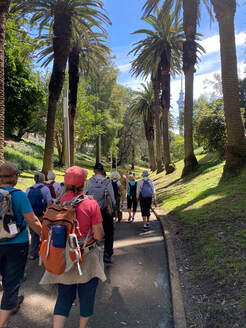 Myers Park with a peek of Sky Tower
Myers Park with a peek of Sky Tower
Myers Park was our next destination and we stopped here for lunch.
Then it was out onto the city streets – down Queen Street, past the Library, up the steps in Khartoum Place, and the steps beside the Art Gallery into Albert Park.
We passed the Clock Tower Building and Old Government House before making our way down to the Centennial Walk entrance back into the Domain.
There were three further points of interest before we returned to our cars - the Reflecting Pond with three bronze figures representing Wisdom, Strength and Bounty of the Earth, the totara grove and the Bledisloe Memorial.
A great day full of diversity, good company, and fine weather!
Thanks to our leaders, Shona and Linda, and our photographers Barbara and Linda.
And, a special thanks to all our members who have been so patient waiting for 2023 to get underway!
And, a special thanks to all our members who have been so patient waiting for 2023 to get underway!
